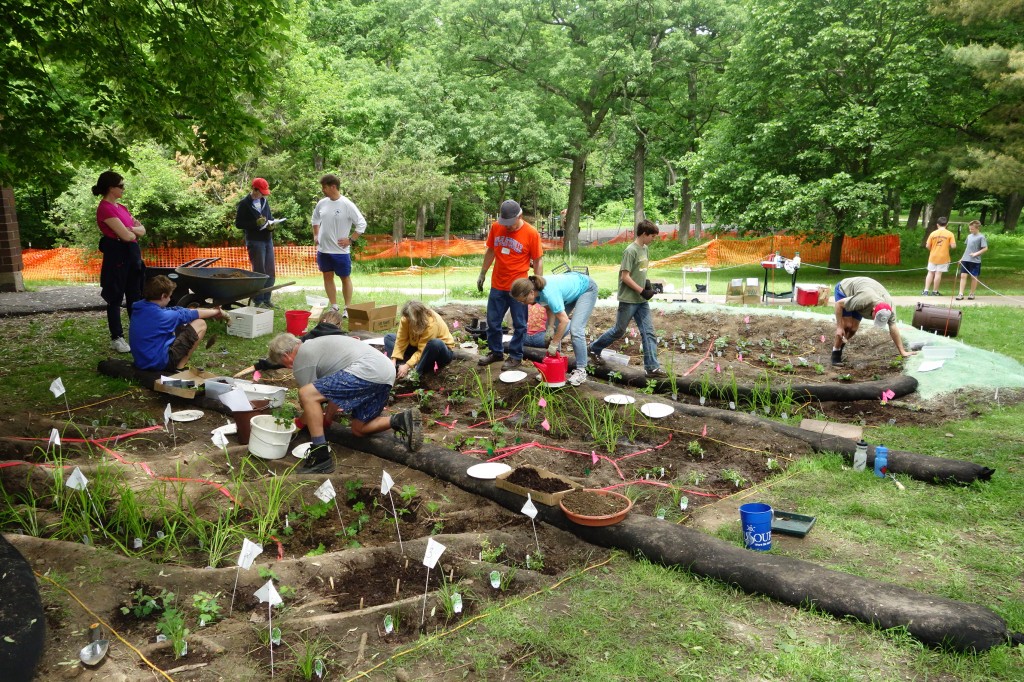Homeowners in many parts of the country are catching on to rain gardens – landscaped areas planted to wild flowers and other native vegetation that soak up rain water, mainly from the roof of a house or other building. The rain garden fills with a few inches of water after a storm and the water slowly filters into the ground rather than running off to a storm drain. Compared to a conventional patch of lawn, a rain garden allows about 30% more water to soak into the ground.
Why are rain gardens important?
As cities and suburbs grow and replace forests and agricultural land, increased stormwater runoff from impervious surfaces becomes a problem. Stormwater runoff from developed areas increases flooding; carries pollutants from streets, parking lots and even lawns into local streams and lakes; and leads to costly municipal improvements in stormwater treatment structures.
By reducing stormwater runoff, rain gardens can be a valuable part of changing these trends. While an individual rain garden may seem like a small thing, collectively they produce substantial neighborhood and community environmental benefits.
Rain gardens work for us in several ways:
- Increasing the amount of water that filters into the ground, which recharges local and regional aquifers;
- Helping protect communities from flooding and drainage problems;
- Helping protect streams and lakes from pollutants carried by urban stormwater – lawn fertilizers and pesticides, oil and
- other fluids that leak from cars, and numerous harmful substances that wash off roofs and paved areas;
- Enhancing the beauty of yards and neighborhoods;
- Providing valuable habitat for birds, butterflies and many beneficial insects.
How can I learn to plant one?
Learn with us during our rain garden design workshops and our hands-on community work days, where we go through the ABCs of soil preparation, planting, and maintenance of rain gardens. For an introduction, see the WI Standards Oversight Council DNR rain garden manual. Sue Ellingson has a very good web site (Sue’s Rules for Rain Gardens) that includes a wonderful plant list. Edgewood College also has a website dedicated to the topic.
I want to see one. Where can I go to look at a rain garden?
- Edgewood College (east side of the Edgedome, capturing water from the Campus School parking loop)
- 614 Piper Drive
- 1922 Vilas Ave
- UW Arboretum Visitor’s Center
- Spring Harbor Environmental Magnet Middle School
What is FOLW doing to promote rain gardens?
FOLW and partners facilitated the construction of a rain garden street demonstration project in the Vilas Neighborhood, where rain gardens are dug in the terrace, between the street and the sidewalk. Unlike typical rain gardens that collect roof runoff, these gardens capture runoff from the street. Street runoff dumps a lot of dirt and excess nutrients into Lake Wingra and many other lakes and rivers. (Storm sewers are simply concrete pipes; water in them isn’t cleaned in any way.)
Making a dent in street runoff with something as low tech as a garden is an idea with remarkable potential. A rain garden is a green machine that’s cheap and effective. The tough question is how to create gardens that look good and are easy to maintain. With this project, we hope to find some answers.
FOLW Partners with City of Madison
FOLW wrote a grant to fund the Rain Garden Street. The money was awarded to the City of Madison, which has engineered the project and hired landscape designers Margaret Burlingham and Hope Oostdik. Neighbors on Adams St. met individually with Margaret and Hope to design gardens that suit them. The gardens were completed in 2006 as part of a previously planned street reconstruction.
Read more
- Learn more about the Adams Street project and check up on its status
- Learn more about the rain garden streets in Seattle, WA that inspired the Friends to explore this idea and bring it to Madison

